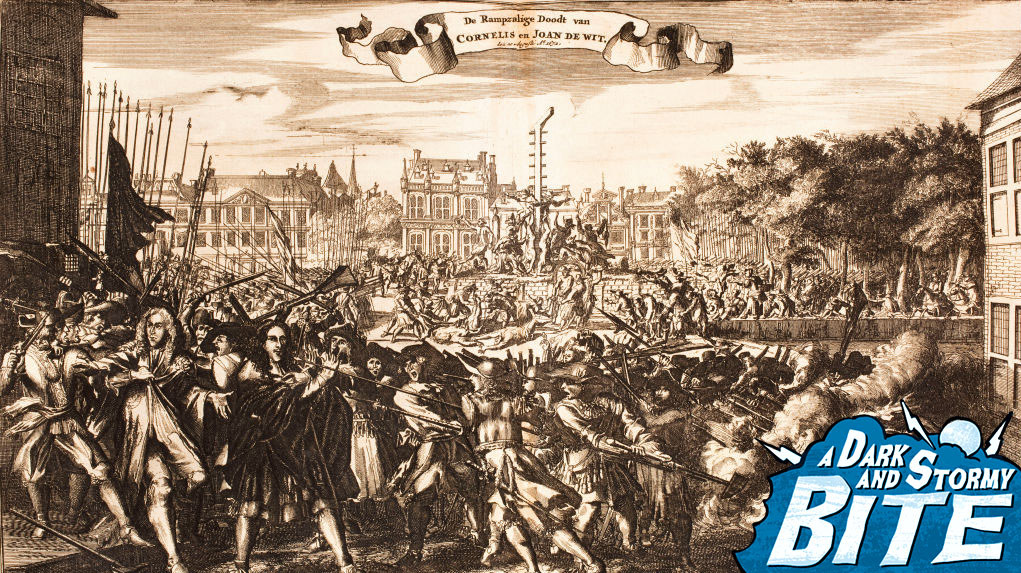A Dark And Stormy Bite: That Time A Bunch Of Dutch People Ate Their Prime Minister
We kick off our new horror column with a look back at apocryphal cannibalism.
Welcome, foolish mortals! Come closer—closer, I say!—if you'd like to partake in a cadaverous casserole. A yarn of exsanguinous eats. A saga so strange and frightening it may well transport you to a realm unknown. Welcome, readers, to A Dark and Stormy Bite.
(This is where you can clap your hands to imitate thunder crashing. Got it? Okay, cool.)
With each column, we'll dive deep into a teeth-chattering culinary dimension of utterly ghoulish proportions. Floorboards will creak as we peer into the food world's otherworldly legends, terrifying traditions, and occasional cannibalistic dabblings. Basically, if it involves food and goes bump in the night, we'll cover it here.
This week, we're tucking into a legend from a faraway land. A land where the air is deathly still and smells faintly of raw human liver. A land where the foreboding clip-clop of wooden clogs rings through the cobwebby alleys. I'm referring, of course, to the Netherlands. (Cue another thunderclap here.)
Our story begins in 1650 with the untimely death of William II, Prince of Orange and heir to the Dutch branch of Europe's aristocratic dynasty, the House of Nassau. Enter Johan De Witt, a young political wunderkind who worked alongside members of the wealthy Dutch merchant class to bring down the monarchy and create a republican regime. He was later appointed as the Republic's Grand Pensionary (basically a fancy way of saying prime minister). The future looked bright for De Witt—until it didn't.
Fast forward to 1672, also known as the Year of Disaster in Dutch history. That's pretty much exactly what it sounds like. The year kicked off with the beginning of the Third Anglo-Dutch War, during which Louis XIV of France was able to conquer a large portion of the country. The diabolical French invaders made their way toward Amsterdam; meanwhile, De Witt was hyper-focused on the merchant vessels that helped keep his family's fortune afloat. The Dutch people were scared, the Dutch army was enraged, and everyone wanted someone to blame. That someone was Johan De Witt.
At this point, a group of so-called Orangists started calling for the royal House of Orange to step up and retake power. De Witt was then severely wounded by a knife-wielding assassin; meanwhile, his brother Cornelis was arrested on charges of treason against the House of Orange. This all forced De Witt to load up the family truckster, resign as Grand Pensionary, and retire to the Keys. (Or the Dutch equivalent of the Keys. The Kaas?) But the angry Orangists weren't going to let him off that easy. Thus came the fateful day when a bunch of Dutch citizens clomped to the clink and made a tasty snack of the brothers De Witt.
(Insert one more thunderclap here if you're into it. No worries if not.)
On August 20, 1672, De Witt swung by Gevangenpoort at The Hague, the prison where his brother Cornelis was being held for treason. Cornelis had been sentenced to exile, so De Witt strolled over to the Big House to bid Cornelis farewell before he started on his merry way. De Witt and Cornelis were hanging out, probably attempting a brotherly embrace while a tights-clad guard screamed "Niet aanraken!" But suddenly, an Orangist mob burst into the prison. Their goal: to tear the De Witt brothers limb from limb as punishment for their treason and failed leadership.
This is not hyperbole. According to BBC History's History Extra, the brothers were shot, stripped naked, and then dragged to a nearby public gallows. After they were strung up, the Orangists burst into a Hannibal Lecter-y frenzy. Yes, dear readers, the Dutch mob reportedly started eating the brothers' bodies. Most accounts say the crowd focused on the victims' livers (nutritious!), while others detail some random person plucking one of De Witt's eyeballs from his skull.
I know what you're thinking: Did this really happen? Did a horde of Dutch nationals really dine on their recently disgraced prime minister and his treasonous brother? And if so, did they at least cook the livers before they ate them?
The attack might seem far-fetched, but eyewitness accounts and art inspired by the event all have the De Witt brothers looking quite flayed. In fact, people used to snatch "souvenirs" from executions all the time. Souvenirs of the fleshy variety. Consider Oliver Cromwell's head, which was placed on a 20-foot spike long after his death. Or the commoners who reportedly dipped their handkerchiefs in the blood of King Charles I after his execution. Hell, you can pop into any large European cathedral and find at least one saintly fingernail or incisor. But as far as I can tell, this is the only case of mob mania resulting in political execution turned feast.
This is the first installment of A Dark and Stormy Bite. Keep an eye out for our next column, which will focus on an equally terrifying culinary catastrophe. Do you have a favorite haunted restaurant or cursed recipe? Know of another finger-licking Dutch execution that I may have missed? Sound off, dear readers—and beware.
